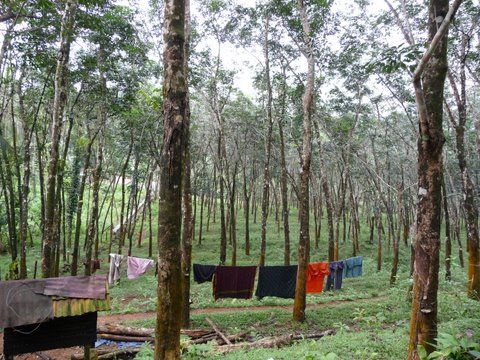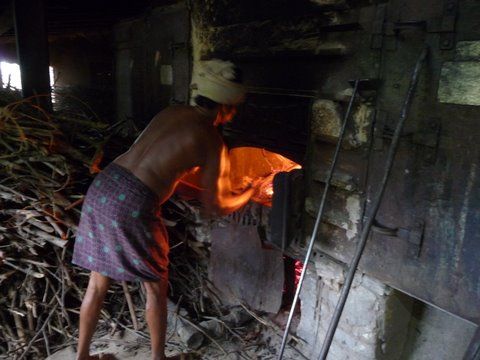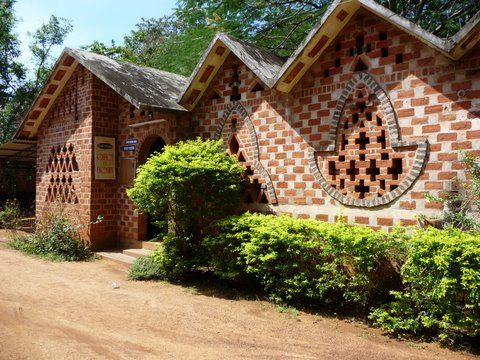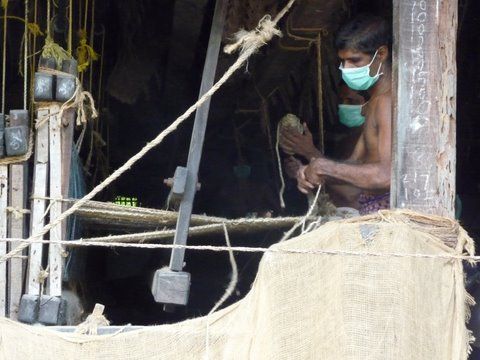Kochi (Cochin), November 27 — In the 1990's, the wordsmiths in New Delhi struck upon "Incredible India" as shorthand for the world's most populous democracy. Not to be outdone, Kerala's rulers rebranded their state "God's Own Country," a slogan now seen everywhere. But three thoughts occurred to us after spending ten days traveling through Kerala: (1) that the apostrophe should appear at the end of the first word, given the plurality of divinities in this intriguing state; (2) that among these deities is the Marxist god that demonstrably failed the former Soviet empire; and (3) that Communism here has half-succeeded, and half-failed in interesting ways.
Much has been written about Kerala's quality of life, its achievements in literacy, health and empowerment of women. But we found that God's Own Country is also vulnerable to mortal misjudgments and adverse external forces.
As we learned in Mumbai, access to jobs is a major source of communal strife. In Kerala, the lack of jobs for its educated citizens is an omnipresent challenge. Unemployment in the state hovers around 25 percent, depending on how and whom you count; roughly twice as many women as men are jobless. Kerala has no industrial base. Workers are unionized and wages are high compared to neighboring Tamil Nadu. Land is in short supply and expensive; consumer goods are imported. Jumbo-sized billboards pepper the landscape; television commercials interrupt programming—a Mad Man's delight. Print journalism flourishes, and people are indeed well-informed and opinionated. But in the words of a friendly critic, "Keralites know their rights, but not their obligations."
On our journey we have seen several attempts to mitigate the relentless consumer pressure on a weak economic base by promoting eco-tourism, nurturing manufacturing cooperatives founded a half-century ago, and disbursing micro-loans to seed small businesses. The intentions are admirable; the limitations severe.
Early on, we visited a popular tourist destination, the hill station of Ponmudi, nearly three hours by car from the capital, Trivandrum. But whereas the ancient Romans excelled at constructing ruler-straight roads, Keralites have produced what must be among the world's greatest collections of hairpin turns (22 in the final stretch).
On leveler terrain, public and private buses, trucks, motorcycles, bikes, auto-rickshaws and cars hurtle through roads blocked by armies of pedestrians, cows, protest demonstrators and the occasional temple elephant accompanied by his or her mahouts. A recent cover story from India Today noted that India has the highest number of road accidents in the world: by last count, 13 every hour, 114,590 a year. Safety aside, public transport is sluggish, inadequate and subject to periodic strikes, this infrastructure is palpably inhospitable to large-scale eco-tourism. As a headline in The Hindu puts it, India is a country "Where the Pedestrian Is a Third-Class Citizen." Sidewalks are a rarity in Kerala.
On the plus side, Kerala also has few high-rise buildings and its major cities leach horizontally into a web of villages. Whereas elsewhere in India rural dweller swarm into major cities already choking with slums, in Kerala it is hard to say where one town ends and another begins. This is what locals call rurbanization (rural + urban). Moreover, there are no communal ghettos: Hindus, Christians, Muslims live side by side with a scattering of Jains. When Keralites travel, they are indifferent to the religious preferences of the hotel owner. "Unlike northern India, in Kerala there is no 'Muslim water' and no 'Hindu water,'" remarked Calicut University Professor M.N. Karassery.
Near Ponmudi, we visited the Merchiston tea estate, watched rubber being tapped, and strolled through the lush vegetation – banana plants, coconut palms, and banyan trees punctuated by red hibiscus, pink pepper vines and yellow honeysuckle. Here tea leaves are cultivated, harvested, dried and processed in a manner largely unchanged since the British turned over the factory more than 60 years ago.
However picturesque, in reality overall agricultural production has plunged in both Kerala and India as a whole. Owing to a major shortfall in rice, blamed on weak monsoons, India for the first time in 20 years is about to import this basic commodity. Kerala means "the land of coconuts" but lately many go unpicked. Although poor locals are unemployed, they very humanly resist the dangerous work of climbing the trees to harvest the nuts – better leave it to the Tamils, they say, who will work for half the wages.
The green movement faces similar dilemmas. Thirty years ago, the Silent Valley Forest campaign was led by the 40,000-strong People's Science Movement. A proposed hydro-electric plant was supported by the state government but environmental activists—engineers, agronomists, biologists—issued a report on the project's impact on this "rare tropical evergreen rainforest." More crucially, they managed to convince then-Prime Minister Indira Gandhi, who flew over the area, to save it.
Mrs. Gandhi's intervention illustrated the vulnerability of Kerala's monsoon-dependent environment to policies adopted elsewhere, notably New Delhi (and soon probably, in Copenhagen). Still, it also needs saying that resourceful voluntary organizations are laudably trying to stretch the state's human and natural resources.
This energetic endeavor is illustrated by the Costford Center for Science and Technology for Rural Development in the Thrissur region. In the Attappaday Hills, the late U.K.- born architect Laurie Baker fashioned a rustic campus of low-roofed brick buildings within which a voluntary staff of professionals conduct courses in everything from house construction to computer skills.
The center's signature achievement, as described to us by Director T.R. Chandradath, has been promotion of livable yet frugally produced houses using locally made bricks and tiles, each unit with its own septic tank. The group's purpose, to quote its mission statement, is "to change the social, economic and political position of the poor, the deprived, the oppressed and the weak."
That same evening, the awesome scope of the challenge was detailed by the environmental activist C.R. Neelakandan. Kerala's forests are gone, he told us, and the topsoil depleted, and water storage capacity reduced. "Keralites are not producing what they use, and not using what they produce. Everything is produced elsewhere." Trucks clog the city centers disgorging goods before returning empty. According to Neelakandan, Kerala has no control over its economy, and is increasingly hostage to the changing prices of cashews, coconuts, tea and coffee, posing dilemmas that are rarely addressed by the state's politicians, leftist or centrist.
The melancholy result became apparent in a cooperative society of local weavers formed in 1952 in order to employ poor workers at reasonable wages. Initially it manufactured shirting and lungis (the garment worn on the lower body by men). During the 1970s, it began exporting satin bed sheets and other furnishing fabrics to other states and the U.K. Their exports peaked in 2003-4 and have declined rapidly since. Faced with competition from the machine looms of China, local hand workers, even with government subsidies, are losing out. Owing to strict government regulation of cooperatives, its managers are unable to take prompt decisions which might turn things around. Lacking capital and the will to mechanize, they are shedding workers. Their scant hope lies in obtaining funds to attend trade fairs in order to better publicize their product.
A few days later we visited the Coir Mats and Matting Cooperative Society in Cherthala where they were undergoing a raw materials crisis. The coconut fiber essential to the production of their matting is being sold for better prices by fiber mill owners in neighboring Tamil Nadu to the Chinese. Kerala no longer produces it in enough quantity to meet demand. We visited a factory complex which is now three-fourths empty. Coir production had stopped; the workers who were left had switched to jute, imported from faraway West Bengal.
In this region, cottage industries are dominated by the Ezhava caste, the largest Hindu community in Kerala. Their yellow banners alternate with the Communist hammer and sickle. Workers are divided into direct (working in-house) and indirect (employed at home) workers. All are paid by piece work. A full day's labor brings in about 150 rupees, or little more than $3. A few years ago there were more than three-hundred workers; now there are 165.
Families have passed down their weaving skills from one generation to the next but their mood, judging by our informal talks with the workers, is decidedly downbeat. Any marketing innovations that they might adopt, such as branding their product as eco-friendly, or touting their natural fibers and natural dyes, or changing the patterns for their mats, would likely be copied at once by their private sector competitors, their marketing manager assured us. These rivals are not constrained by government rules, they innovate rapidly, don't pay set wages and can lay off redundant employees.
A more optimistic note was struck when we visited the Kudumbashree Unit of a women's self help group in Thalassery. In a rudimentary but hygienic shed, ten workers make a nutritious food supplement to be mixed with water for children under six. They obtained a micro loan eight years ago which they repaid from their profits in three years. Women have been major losers in the rural economy since their traditional jobs have been eliminated in favor of the male-dominated cash crops. But these women have made the transition.
And the economic shortfall in God's Own Country is compounded by the outflow of educated Keralites, the focus for our next report.

















